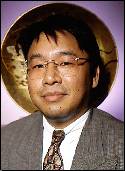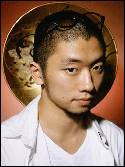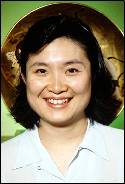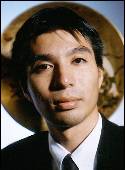Seven Who Dare
Back to Contents of Issue: December 1999
|
|
||||||||||||||||||||||
|
by Bradley Martin |
||||||||||||||||||||||
|
I
personally don't like computers so much," says Kazutomo Robert
Hori. Having grown up idolizing his swashbuckling grandfather
-- a supersalesman and hotel entrepreneur who thrived on both
personal and business risk -- Hori is not one to sit in his
room surfing the Net. Rather, his idea of a good time is to
get outdoors, where he'll try just about anything-he once
went bungee jumping in New Zealand. His favorite pastimes
are skydiving, skiing, and especially wake boarding, which
is something like water-skiing but on a single board and employing
acrobatics akin to those of skate-boarding. In other words,
the 34-year-old global pioneer of the brand-new business of
putting content onto cellular phones' tiny screens is not
your typical Japanese CEO.
An
adventurous seven
They tend to have blockbuster projects on tap that they can't talk much about even as they pound their chests. "What I'm planning will be big news in the Japanese graphics industry," exults Takao Hiramatsu, president of Digital System Inc., as he drops a few hints. How to finance those projects? Contrary to the situation just a few months ago, these young e-preneurs are finding that it's easy to get capital. Suddenly the venture capitalists are approaching the entrepreneurs, instead of the other way around. A couple of weeks spent with these seven and other Net-related Tokyo entrepreneurs suggest that, while samurai-style courage is high, traditional Japanese social barriers are starting to crumble-due in part to transplantation, via the Silicon Valley, of California-style informality. Networking is a snap for this wired generation of Japanese. Someone seeking information can send an e-mail, even without having received a proper, Japanese-style introduction, and actually get a same-day reply. If the Japanese respondent is an English speaker, his or her reply may well seek to establish instant intimacy by using first names. Informal networking is organized now. There's Sigma Jay, a Web-based mutual support group. And the Bit Valley Association (see the November 1999 J@pan Inc.-Ed.), composed of 100 or so entrepreneurs, gathers for monthly pub sessions (with more and more VC types attending to have a look) in Shibuya, locus of much of the new activity. These entrepreneurs proclaim that the Internet's time in Japan is now, and they feel sure the Net is going to be very big indeed. Takashi Hakii, president of applications service provider Tricorn Corp., likens Internet use to the mobile phone, saying it will in short order become a virtual necessity for doing business. He figures it won't take long for the Net to match the 35 to 40% penetration rate in Japan of the mobile phone. With that sort of momentum building, it stands to reason that young entrepreneurs can move faster than their predecessors in the U.S. did -- to the extent they can grab and use tested American business models. Meanwhile, though, Tokyoites already have begun thinking of new twists that apparently hadn't caught on yet among the Americans.
Contributing Editor Bradley Martin is former bureau chief for Newsweek and The Asian Wall Street Journal amd most recently was co-founder and managing editor of Bangkok-based Asia Times Online. One biggie is the concept of the cellular phone as an entertainment and news medium. Hori says it came to him while he and a partner were running a popular but financially unrewarding website called Paradise Web. Ad sales were bombing because the Japanese market wasn't yet ready for Internet advertising. "The more popular the site got, the more money we had to spend, the harder we worked, and the poorer we got," Hori recalls. It struck him that a cellular phone company charges the user every month and collects the money, like clockwork. Pondering that, he realized that he could "use the cellular phone like the Internet. Like you can play a game with your cellular phone and, when you get bored, click a button and a new version of the game can be downloaded." "We went to several cellular phone companies in Japan and none of them understood. They said: ÔAre you crazy?'" Hori kept trying to persuade them by outlining his vision of a world that would look very much like . . . well, like the one that has in fact come to pass in 1999 with the introduction of NTT DoCoMo's digital mobile services. Cellular phone users can now select from a computer-style menu of potentially helpful categories of information, news, and entertainment. But back in the Dark Ages three years ago, Hori's vision seemed a strange one indeed. It took him two years not only to persuade DoCoMo to make the "webphone" happen and to sign him up as official content provider, but also to persuade Omron, joined by Itochu, to back him in the establishment of his company. Cybird Co. Ltd. was formed in September 1998 and by February this year, DoCoMo was on the market with its i-mode phone. While it's not the Internet, "it basically is an internet," says Hori. Meanwhile, boldly ignoring the boundaries between the traditional Japanese business groups (kei- retsu), he has been contacting other cellular phone companies, lining up deals with J-Phone and DDI for similar services. The most unusual Cybird feature among the 80-some categories of content the company provides for phone users is its weather, traffic, and surf-condition reports on surfing beaches around the country, updated every six hours with reports from local surf shops. "This is really like a bible to all the surfers in Japan," says Hori, who boasts that 30,000 of them subscribe. The ¥300 monthly fee is added to a user's monthly phone bill. And what's
the future for cellular phones-with-content? Close to two
million DoCoMo i-mode phones have been sold so far, Hori says
-- while the total universe of currently used cellular phones
in Japan is 45 million. Some estimates are that half of those
users will have switched over by March 2001. Meanwhile, "Cellular
phone companies worldwide are aware of what NTT DoCoMo is
doing" -- and this Japanese-developed idea has just hit the
U.S. No wonder big shot venture capitalists like H&Q, Intel,
and C.S. Ho have agreed to pour some $4 million in new capital
into Cybird in preparation for an IPO planned for next year.
Tough job, as they say, but somebody had to do it. Jiro Funakawa started his first company while still a student at Waseda University. His older brother and sister at the time were working for a publisher whose hip magazines were aimed at college-aged readers. They needed a steady supply of new faces for modeling assignments. So the handsome, square-jawed Funakawa formed a company and set up campus organizations attracting lots of women, from among whom he recruited the prettiest. As graduation approached, Funakawa still had the entrepreneurial bug. He went to the usual job interviews with corporations -- but warned each interviewer that, if hired, he would not be a lifetime employee. He would learn enough to leave within five years and start another company of his own. Recruit Corp., itself a brash and fairly young company, and far from being turned off by this college boy's cockiness, made him an offer. "I thought, ÔHey, this is an interesting company!'" recalls Funakawa. He accepted, and turned over the campus modeling agency to his juniors in the School of Commerce. As he had predicted, five years turned out to be how long it took Funakawa and a colleague to come up with some ideas for a company of their own. Once again he is involved in the temporary student employment business -- but this time, as president of Digit Co. Ltd., he's dispatching engineering graduate students to work in high-tech companies. The way it happened was this: Involved in development of Internet-related business for Recruit, Funakawa and a fellow employee proposed using the Net for recruiting activities. But they found that even at such a seemingly future-oriented company their seniors were cautious about what was still, for most Japanese, unknown territory. That led them to some introspection about the Net as the ideal medium for young people, thanks to a built-in equalizing tendency that contrasts with the age-based hierarchical system found in established Japanese organizations. In 1995, they pooled ¥10 million from their own savings and formed a company, which began by working with Keio University engineering students to create the first Japanese search engine that wasn't copied from an American original. The search engine proved to be ahead of its time: It was a technical success, but the company lacked funds to promote it -- to a market that, anyhow, wasn't ready for it. Other company initiatives in those early days were similarly experimental, yeilding interesting results but costing more (even though low-wage students were doing the work) than they brought in. Eventually, Funakawa moved to reduce the emphases to just two businesses. One is billed as Japan's first full-scale service for placing engineering students in temporary jobs in the high-tech sector. That provided about 40% of Digit Co.'s sales of ¥275 million in the fiscal year ending April 30. The student dispatch business is designed to tap the skills of graduate students -- who are not only cheap but may be closer to the cutting edge than many engineers already working in the field. Funakawa, now 32, is considering an IPO in Japan centering on the student placement business. He's planning to do big things in networking and marketing using the company's database of alumni and current participants. The other, larger share
of revenue comes from software development, often employing
some of the students on Digit's temp-jobs roster. There the
company's timing has changed drastically for the better. Currently
hot: its interactive Agent system, which combines a simple
artificial-intelligence program with super-cute, three-dimensional
animation-style characters that can teach English, for example,
or converse with insurance prospects about their resources
and needs before proposing a policy. Sony Life Insurance and
Lado College are local users. Late in October, Funakawa was
heading to Silicon Valley for a presentation of Agent to a
VC firm that had expressed serious interest -- and indeed,
he says, had offered him ¥1 billion, which is more than
he wants.
Imagine you're in charge of color magazine ads for Toyota. You want to picture a new four-wheel-drive model in a wilderness setting high in the mountains. What to do? You could, of course, employ a staff of 20 or so people to haul the car up the mountain, keep it in showroom condition throughout the job, and then shoot many rolls of film. But the job would cost maybe ¥5 to 10 million, and it would take a month. Fortunately, these days you have a far cheaper alternative. You can leave the car in the factory, have the photographer trek up and shoot only the wilderness background scene (or buy it from National Geographic) and let Digital System Inc. put the car into the picture using computer graphic 3-D imaging technology. The process takes a staff of two people only two weeks and costs Toyota considerably less than half as much as taking the car to the mountain. It's also cheaper than synthesizing purely photographic images of the car and the natural background. And if you want to alter the picture for other markets -- say Toyota uses a different wheel cover design in some of its European markets -- Takao Hiramatsu's shop can easily plug the change into the overall image with no loss of apparent realism. Hiramatsu started Digital Systems in 1996 and became a pioneer. "At that time, people said the quality of 3-D technology was too low for printing -- you could use it only for television," he recalls. That's what people said, but Hiramatsu is a contrarian. (He had quit Nihon Color Engineers after nine salaryman years there when colleagues balked at his proposals to reorganize the company in the face of changing circumstances.) With 3-D technology, he concedes, "a few years ago we could create only a toy-like car, not a real-looking one." But with the encouragement of clients, beginning with Sony, Hiramatsu began to prove that technology, such as Shade software from Japan's Expression Tools, had evolved to the point where it was eminently usable in color printing. Hiramatsu served as his
own angel, using his savings to set up what he calls a "family company." (His
wife works with him. He expects his son, who started elementary school recently,
to join when he's in his teens.) Now 36, Hiramatsu says he is grossing ¥50
to 60 million per year. He has had several approaches from people offering venture
capital for expansion, but says: "I will think about that in the future, not now."
For now he keeps the core operation small. When he needs extra people to help
on individual projects he logs onto design-related websites where SOHO designers
who live in various parts of the country hang out their virtual shingles to offer
their services as telecommuters. "I've organized a virtual company via the Internet,"
he boasts.
Takashi Hakii was a consultant at Price Waterhouse when he noticed that no one in Japan offered compact critiques of websites of the sort that he himself wanted to be reading. Accumulating his own information and dipping into his savings for initial capital, he started Tricorn Corp. in 1997. Nearly three years later, he boasts that his First News (www.firstnews.com) site has 62,000 member-subscribers who get their twice-weekly e-mail newsletter spotlighting hot new URLs free -- but whose loyalty inspires advertisers to plunk down ¥100,000 a pop for five-line ads. The newsletter, staffed by two people, more than pays for itself. Along with Buyers -- Tricorn's free-classified Net service putting together shoppers, who key in their wish lists complete with prices, with stores that are willing to accommodate them -- First News gets Tricorn's name out. Thus both of these B-to-C services yield free advertising for Tricorn's B-to-B moneymaker, Autobahn. Autobahn sells corporate clients Internet access to several software applications that the clients would find far more expensive to buy and support on their own. Recruiting new graduates, for example, is a seasonal activity in Japan. "If a company has that software, they don't use it from May to October," says Hakii. "It's expensive for them to have that software on their site" -- it costs a lot to buy in the first place, takes up space on the server and requires connection fees and a payroll for administrators. Some major companies have decided it makes more sense for them to pay what is essentially a leasing fee and turn the job of owning and maintaining such a system over to Autobahn -- which provides them passwords to access the software on sites it sets up for them. Other software that it rents out in this fashion includes seminar organizing, polling, and e-mail distribution programs. Hakii,
now 34, started Autobahn in early 1998, and says it was only
later that he read about the ASP (applications service provider)
model in the United States and realized it was similar. Autobahn
brought in about ¥30 million the first year and ¥60
million the second, he says, and it's headed for a ¥100
million total in the fiscal year ending this December 31.
Hakii plans to increase the company's capitalization this
year, and says he's been approached by "many" venture capitalists,
some of them Japanese. He'll do an IPO in the "near future,"
he adds.
Two of our young e-preneurs are really young -- still in their 20s. The youngest, Jun Saeki, entered a contest to design a commercial for MTV at age 16. His sketches of faceless salarymen, lined up like soldiers on trains and sprawled drunk on the station platform, needed no accompanying words to bring home to viewers the choice the budding designer saw as confronting his contemporaries. Saeki -- who, by the way, says he has learned his excellent English by watching MTV -- was nominated for a prize, his name mentioned on television. An official of the automation company Yamatake Honeywell took notice and hired the high school student part-time to do illustrations for its publications. The company sat him down in front of a computer with Photoshop installed. Unwilling to admit that he didn't know how to use it, he crept out during break times to stand in a nearby bookstore poring over how-to books until he figured it out. Thus was a career launched that was to lead to Saeki's establishment of his own design company. The Net was just then becoming popular in Japan. Young Saeki designed his first website: the home page of composer-pianist Joe Hisaishi, father of one of his kindergarten classmates. As webmaster, he received speedy and voluminous feedback from surfers, who e-mailed mostly praise. The access log showed visitors from more than 30 countries. "This was satisfaction for a designer." Hakii, now 34, started Autobahn in early 1998, and says it was only later that he read about the ASP (applications service provider) model in the United States and realized it was similar. Autobahn brought in about ¥30 million the first year and ¥60 million the second, he says, and it's headed for a ¥100 million total in the fiscal year ending this December 31. Hakii plans to increase the company's capitalization this year, and says he's been approached by "many" venture capitalists, some of them Japanese. He'll do an IPO in the "near future," he adds. At the College of Environmental Information of the prestigious Keio University, where he enrolled in classes in computer graphics and environmental design, Saeki sought out like-minded designers among his classmates and started a club. Meanwhile, he worked on a Gillette promotional campaign centered on the soccer World Cup. Besides the website, he also designed the product's packaging. Saeki recalls: "That was the first time I realized the importance of media mix. I should do not just Internet, but broadcast, magazines, etc." More jobs came in, and meanwhile he got an introduction to Reugene Nishikawa, a marketing consultant who had started his own company while a university student and had a soft spot in his checkbook for promising kids like Saeki. Nishikawa said, "All right, I'll give you ¥10 million. Why don't you start a company?" Saeki's parents were against the move. His father works for Fujitsu and his mother is an IBM alumna; they argued for at least starting off at a big company as a way to get some training and develop contacts before breaking away to found his own firm. But Saeki "thought that even two or three years would be wasting my life, because I already had a few clients. I'd been lucky and I didn't want to lose that luck." In September 1998, when he was only 20, he started d-plug inc. So, what
did Saeki do with the money from angel Nishikawa? He upgraded
his computer hardware with some of it -- and parked the rest
in the bank. "I was scared of that huge amount of money and
couldn't use it," he admits. He decided he should "make some
money before using money." In that he was successful: Among
other clients, Sega Dreamcast came through. In this, his second
year, he hopes to earn ¥40 million; in the third year,
¥100 million. The Nishikawa money is still in the bank.
"Right now I'm studying at the university how to use it,"
says Saeki.
With her Chinese ancestry and her trilingual upbringing as a citizen of Japan, it was natural for Meiko Towada to head for Hong Kong after earning her U.S. MBA in 1996. Many of her Northwestern University classmates (who call her "Mae") were involved already in Internet startups so it was likewise natural, as she earned her Hong Kong salary, that she kept on the lookout for her own chance to become a netpreneur. The only question was what she would do on the Net. It didn't take a rocket scientist to see that pitching a website to women in Japan was an idea whose time had come -- one for which not only her gender but her work in content and marketing for Disney's television group in Hong Kong had prepared her. Not that she would have a wide-open field. Women's sites were already well developed in the U.S., and other Japanese likewise were starting to import the idea. Towada needed some sort of niche. She and a group of other women who joined her settled upon the role of a vertical portal that provides filtered information -- solutions, rather than the trendy information typically offered by magazine-style sites. The solutions are keyed to the major decision-making phases in the life of a woman between ages 20 and 39: choice of career; whether and how to marry; whether to have children and, if so, whether to leave the work force, etc. As for the name of the site, they thought it over and decided that Japanese women (for many of whom elegance is the ultimate value or pretty close to it) are less likely to think of themselves surfing the Net than walking or strolling it. Thus they settled upon eSampo.com, sampo being the Japanese word for a stroll. Of course Towada & co. didn't want to stroll. Rather, given the speed of Net development and the advantages likely to accrue to the early bird, they needed to move as quickly as possible to get up and running. For that, "it was really important not to have to worry about money, at least in the short run." With introductions from Northwestern faculty and from Disney colleagues, they interested boutique venture capital combine O'Connor Group in Chicago, which earlier this year handed over just under $1 million. With the money came some free advice, as the angels had been involved with many Internet businesses in the United States. The new site is in beta testing, slated to go fully public toward the end of the year. Already
Towada, 31, is planning her next quest for funds. In seeking
out professional VC money, she plans to look not only in the
U.S. but also in Japan, among both established major corporations
and promising upstarts that can provide a "halo effect" and
help position the business.
Unlike Jun Saeki, Susumu Fujita says he didn't want school studies to figure out how to use the capital he raised to start his Internet advertising agency. The 26-year-old president of Cyber Agent Ltd. boasts that he assiduously avoided going to class during the years he was enrolled at Aoyama Gakuin University-and read only assignments that related directly to the paid work he was doing part-time but on a daily basis in a public relations company. "I was clever enough to figure out how to graduate anyhow," he says. "Japanese universities are like that." As a teenager, Fujita sang in a rock band for six years. Determined to avoid a salaryman's career like his father's, he thought even while still in high school of becoming an entrepreneur. He focused more on the idea after he got to college and determined he wasn't good enough to hit it big as a professional musician. Going to work for Intelligence, an executive-search company, Fujita produced the company's Web-based recruiting pitches. He saw the growing power of the Internet. But he noticed that the Net was used largely by otaku-technical-type nerds. "There wasn't much marketing know-how focused on the Internet here, and I saw a business opportunity." When he decided to strike out on his own with a Net ad business, Intelligence thought enough of his prospects to become a major shareholder-as did such major companies as Hitachi, Softbank, interQ, and Daiwa Securities-SBCM Cyber Agent uses the "click guarantee" model. An advertiser pays a fee and is guaranteed that a set number of people will click on its banner ad and go to its website. Once that number is reached, the ad is pulled. A filtering mechanism uses cookies to make sure that anyone clicking on the banner ad more than once in a 24-hour period is counted for only a single page view. Thus, says Fujita, "I'm not just displaying the ads but guaranteeing the effectiveness of the ads." The guarantee goes over well with advertisers who've grown dubious about other models for figuring Internet advertising revenue. The approach has helped the company reach third place in the Net advertising field, behind only Dentsu-affiliated CCI and Hakuhodo-affiliated DAC, he says. Started only in March 1998, Cyber Agent by September 1999 had achieved total sales of ¥560 million with profits of ¥40 million, Fujita says. Meanwhile monthly sales in September reached the ¥120-million level. Fujita plans to do an IPO worth upwards of ¥10 billion around February 2000 on Mothers, the Tokyo Stock Exchange's new venture capital market. He'll use some of the money for expansion of Cyber Agent's operations. But most of the proceeds he plans to spend for mergers, acquisitions, and investments in other startups, with the goal of making his a broad Internet company. "The border between investor and entrepreneur is quite vague right now," he observes. "Look at Michael Dell and Bill Gates in the United States, or in Japan look at Masayoshi Son of Softbank. They're all entrepreneurs, but also investors." The timing is right for upstart companies like Cyber Agent that have already gotten off the ground, Fujita says. "Many investors started focusing on Internet business in the last six months. It hadn't happened a year ago. The communications infrastructure in Japan has been changing thanks to gaiatsu (foreign pressure)." NTT and a joint venture among Tokyo Electric Power Co., Softbank, and Microsoft are among the players that will be coming out with lower-cost Internet access. "All that means the environment surrounding the Internet business has been changing drastically in a positive way." In three
to five years, he figures, "everyone will be in the Internet,
and differences in Net use between the U.S. and Japan will
disappear." For now, though, Fujita says Japanese suffer -
justifiably -- from an inferiority complex vis-ˆ-vis the U.S.
"The top players in the Internet business here are just imitating
what the Americans are doing. Currently people think it's
safer to just introduce what the Americans are doing. Soon
they'll realize that's a ridiculous idea." |
||||||||||||||||||||||
Note: The function "email this page" is currently not supported for this page.









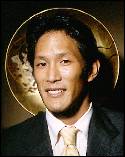
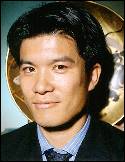 Jiro Funakawa
Jiro Funakawa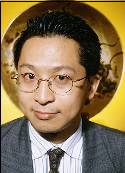 Takao Hiramatsu
Takao Hiramatsu